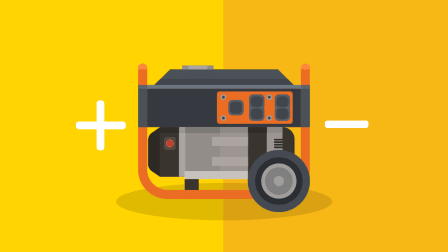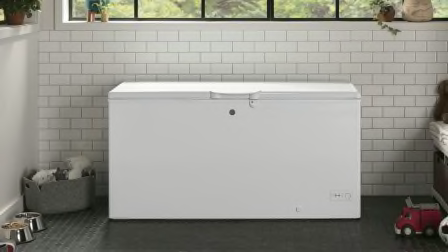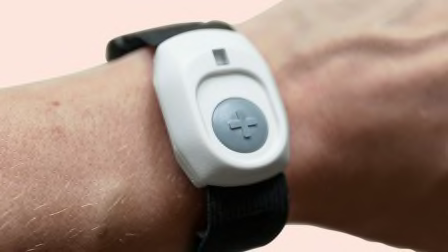Best Flashlight From Our Tests—and Others We Liked
Plus, flashlight FAQs, such as what a flashlight’s lumens mean and how to prolong its battery life
When you shop through retailer links on our site, we may earn affiliate commissions. 100% of the fees we collect are used to support our nonprofit mission. Learn more.
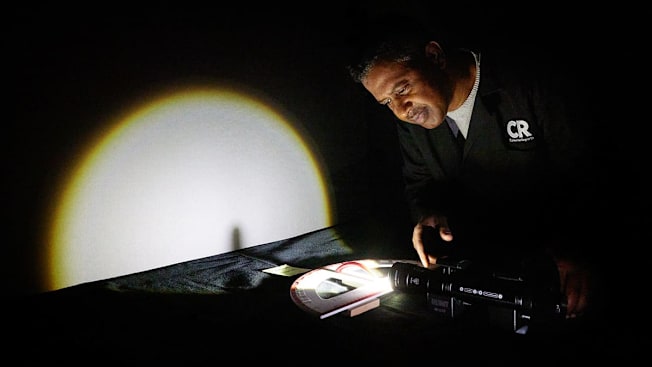
Growing up, my dad always made sure we had a flashlight at home. “You’ll need this in case an emergency happens,” he’d say. And with an extra level of caution, he would regularly check the flashlight to see if it was still working or if the batteries needed to be replaced.
But in the age of the smartphone flashlight, is a flashlight still necessary? The answer is yes, according to our tests. Handy as the flashlight on your phone might be, it’s only powerful enough for trivial needs. Plus, if you’re experiencing a power loss at home or a weather emergency, you’ll want to preserve the power on your phone.
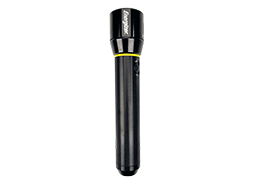
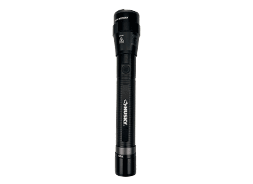
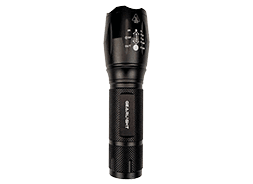
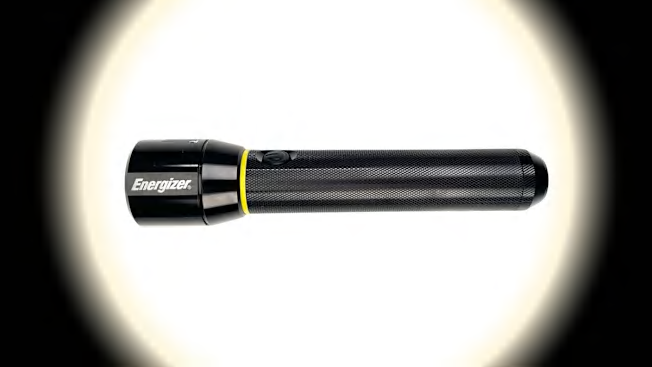
Pros
Its light coverage is incredibly wide. The Energizer Vision HD 6AA Performance Metal Light with Digital Focus has a coverage angle of 160 degrees, the widest among the flashlights we evaluated. In our tests, its beam distance and brightness level were second only to the Husky Rechargeable Focusing Flashlight 5000 Lumens, making it a force to be reckoned with.
It’s extremely comfortable to hold and use. This flashlight scored the highest in our ergonomic evaluation. With a weight of 14.8 ounces, it isn’t the lightest flashlight of the bunch, but it isn’t too heavy, either. It also has a reasonably well balanced feel when you hold it, says in-house ergonomics expert Ritchey.
In addition, the flashlight’s grip area is clearly marked, and the on button is well placed and easy to use. That’s important because some flashlight users in our questionnaire mentioned that they like a flashlight that has an on/off switch that’s quick and easy to use.
Its battery life is long. In our run time test, six fresh AA batteries powered the flashlight for more than 24 hours in the brightest mode.
Cons
It’s not rechargeable. The Vision HD 6AA runs only on alkaline batteries, which might be a deal breaker for those looking for a dual-power or rechargeable flashlight. On the other hand, as a flashlight that uses disposable batteries, this would be a good option for emergency preparedness because it can function without needing to be recharged from a power source, Ritchey says.
Cycling through modes can be annoying. The flashlight has three settings: a high mode, an energy-saver mode that’s less bright, and a strobe. Switching between them can be slightly annoying, Ritchey says, because you have to cycle through them in order, and pass through the strobe mode to get back to high from the energy-saver mode.
Overall Verdict
If you don’t need a dual-power flashlight, consider the Energizer Vision HD 6AA Performance Metal Light with Digital Focus. It’s fairly inexpensive—$22 at the time we purchased it—and offers high brightness levels, a long beam distance, and a wide angle of coverage.
Its wide coverage makes it especially suitable for outdoor spaces such as parking lots or the wilderness, where you want to see what’s in front of you and what might be coming from the sides, says José Amézquita, a CR tester.
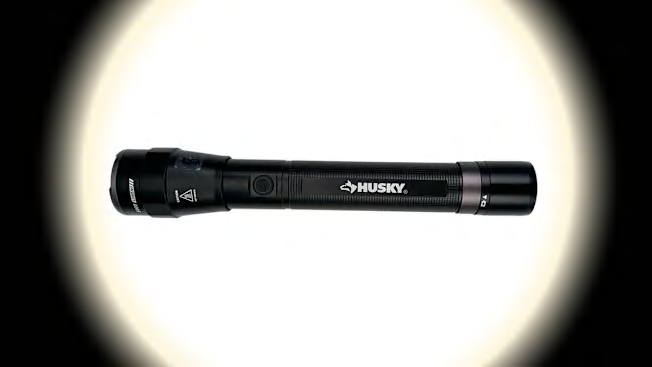
Pros
Its brightness level is high and undeniable. If ultimate brightness is what you seek, then this 5,000-lumen flashlight could be the one. The Husky Rechargeable Focusing Flashlight 5000 Lumens’s brightness level was the highest among the flashlights we evaluated, according to our light meter measurements. And if you want a flashlight that illuminates as far as possible, its beam distance is also the longest.
The flashlight’s coverage is wide. You can twist the flashlight to change its beam from a narrow spot to a wide flood.
It’s dual-powered. That means it can be powered by alkaline batteries or its rechargeable battery. It can also charge other devices through its USB-C out port. This dual option can make it attractive to consumers looking for a flashlight for emergency preparedness.
For everyday use, you can use the rechargeable battery option. And in an emergency, when you’re suffering from power loss, you can use alkaline batteries, Ritchey says.
The flashlight has a battery level and charging indicator. The charging indicator turns green when the battery is fully charged.
Cons
It’s big and on the heavier side. A sleek, full-sized flashlight, the Husky Rechargeable Focusing Flashlight 5000 Lumens is the biggest and heaviest of the 10 flashlights we tested. It weighs 1 pound 10 ounces when used with the nine Amazon Basics alkaline AA batteries, according to our measurements. If you’re using the rechargeable battery, instead of the alkaline batteries, the flashlight is slightly lighter at 1 pound 7 ounces. Its weight might be taxing for longer use, especially for people with smaller hands, Ritchey says.
It’s still comfortable to hold and use, according to our ergonomics evaluation. “It has a good length that allows users to find a comfortable spot to grip and is reasonably well balanced,” Ritchey says.
In its brightest mode, battery life can be a bit short. In our run-time tests (see "How We Tested the Flashlights," below) the Husky Rechargeable Focusing Flashlight 5000 Lumens lasted longer with alkaline batteries than with its rechargeable battery, but its run time still capped off after 5.25 hours.
Cycling between light modes can be annoying. The flashlight has five modes: high light (5000 lumens), medium light (2500 lumens), low light (500 lumens), eco light (10 lumens), and strobe light (lumen level not specified by the manufacturer). When in strobe light mode, the light flashes on and off continuously to disorient animals or other people. To access a certain mode, you have to cycle through other modes by quickly pressing the power button.
This is a point worth noting because, in the Consumer Reports survey of flashlight users, some reported frustration when they had to cycle through all the modes on a single-button flashlight. They also noted it can be especially aggravating if you miss the mode you’re looking for and have to circle back around.
Overall Verdict
The Husky Rechargeable Focusing Flashlight 5000 Lumens might be slightly expensive at $60, but its many attractive qualities make it worth the price. This light excels in brightness, beam distance, and angle of coverage, making it ideal for illuminating open spaces and faraway objects. It’s an excellent choice for use in the wilderness, as long as you don’t mind the weight, Amézquita says.
As mentioned above, its dual power options also make this model a good choice if emergency preparedness is your top priority. Other features that we enjoyed include the flashlight’s ability to charge other devices and its lifetime warranty.
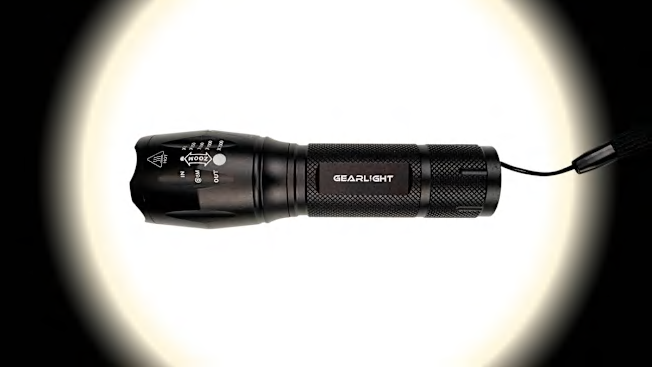
Pros
For an inexpensive price, you’re getting a good amount of brightness. The 1,040-lumen GearLight S1000 LED Tactical Flashlight cost $16 at the time of purchase, making it the least costly flashlight of those we tested.
According to our tests, its brightness level, beam distance, and degree of coverage were all around the middle of the pack, but that’s still a good amount of brightness to get from a low-price flashlight.
It’s perfect if you’re looking for something not too heavy. At 5.5 ounces, the GearLight S1000 LED Tactical Flashlight is pretty light. It’s also compact, which makes it ideal for users concerned about storage space or portability.
Its battery life is long. The flashlight lasted for more than 24 hours in our run time test, one of only three models to do so. The manufacturer suggests using one 18650 3.7v lithium-ion rechargeable battery or three AAA disposable alkaline batteries. The flashlight, however, doesn’t come with any batteries or a charging device for Li-ion batteries, so you’ll have to purchase them on your own.
Cons
The light quality of the flashlight’s spot beam is poor. With this flashlight, you can switch between two beam modes, a spotlight beam and a flood beam. When the flashlight is zoomed into spotlight mode, however, the light distribution is poor, Ritchey says. Instead of a smooth light gradient, you see a square-like array with many hot spots that look like the LED components inside the flashlight.
It might be awkward to grip. There are two ways to hold a flashlight. One is the power grip, with all your fingers wrapped around the handle in the shape of the letter “o.” It’s commonly used when you’re holding thicker, longer, and heavier flashlights. The other is an external precision grip, used when grasping objects like a pen or pencil, or in this case, a penlight.
The size of this flashlight makes neither method very comfortable. It is "a compact flashlight that is too short to afford a nice full grip, so users with larger hands might find it awkward to hold,” Ritchey says. “It is also too thick to comfortably hold with an external precision grip.”
Cycling between modes can also be a bit of a pain. This is one of two flashlights we evaluated that have an SOS mode, a feature that might be useful in wilderness survival situations. In the SOS mode, the flashlight repeats a pattern of three short, three long, and three short flashes (“SOS” in Morse code) as an emergency signal.
As with our other flashlight picks, you need to cycle through different light modes to access the mode you want. “Switching modes is annoying, especially since there is a strobe and SOS mode in between the different light levels,” Ritchey says. The available modes are high, medium, low, strobe, and SOS.
Overall Verdict
All in all, the GearLight S1000 LED Tactical Flashlight offers a lot of bang for your buck. It’s an inexpensive flashlight that boasts a good amount of brightness, long battery life, and dual power. Sure, it might not be the most comfortable to hold, but it makes up for it partly by being lightweight.
Other Flashlights We Tested
The Braun 140 Lumens Pen Light was originally our top pick for the ultra-slim form factor, but it is currently unavailable. Given its lightness and brightness, it’s a good choice for inspection in tight, enclosed spaces. “Because of its length and relative thinness," Ritchie says, the flashlight "should be easy to hold in an external precision grip—like how you hold a pen or pencil—for when light needs to be more precisely directed.” While the flashlight isn’t as bright as the Milwaukee Rechargeable 250 Lumens Penlight with Laser, it’s more durable and survived the drop test we conducted. The Braun 140 Lumens Rechargeable LED Pen Light was still functional after we dropped it from a height of 1 meter. The Milwaukee flashlight, on the other hand, stopped working after the test.
We also like the Anker Rechargeable Bolder LC90 Flashlight, $34, which includes a strobe and SOS mode (available at Amazon and Walmart). It performs well in brightness, beam distance, and coverage angle. It might not be the most comfortable to hold because of its shorter length, but at least it’s lightweight. The flashlight runs on rechargeable batteries, but, as Ritchey says, its charging port can be difficult to access because users have to unscrew its base first.
Another flashlight we think is worth your consideration is the Husky HSKY1200DPFL (normally $35, but unavailable at Home Depot as of this writing). It’s essentially a smaller, lighter version of the Husky Rechargeable Focusing Flashlight 5000 Lumens. While it isn’t as bright or as comfortable to hold as our editor’s choice, it still shares many of the same qualities that we enjoy in the Husky Rechargeable: dual power, the ability to charge other devices, and a lifetime warranty. It also has a longer battery life than than its larger brandmate.
Other flashlights we tested include the Fenix PD36R Pro Flashlight, the Duracell Durabeam Ultra, and the Streamlight Microstream USB Pocket Light.
The brightness of all the flashlights we tested was significantly higher than that of an iPhone 14 Pro. While the flashlight on your phone can be used for emergencies, it shouldn’t be your primary source of light, Amézquita says.
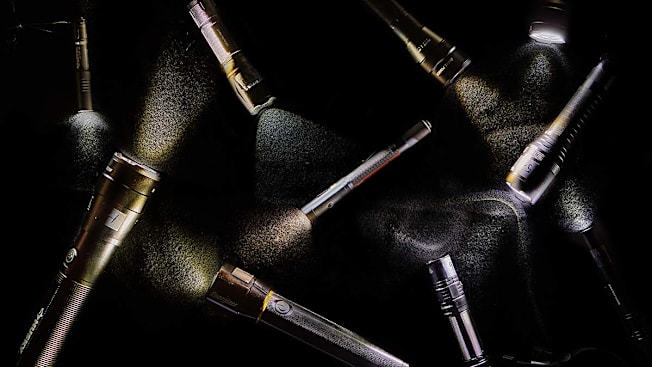
Photo: Scott Meadows/Consumer Reports Photo: Scott Meadows/Consumer Reports
Frequently Asked Questions About Flashlights
Lumens Are Frequently Mentioned When You Look at Flashlights, but What Are They?
Lumens measure the total amount of light emitted from a light source. They are essentially a numerical value used to describe the perceived power of a flashlight, or, in layman’s terms, how “bright” a flashlight is, says Blake Anglin, operations manager at flashlight manufacturer Fenix Lighting.
They’re not the only measurement used to evaluate a light’s overall brightness. Another important factor is a light’s candela rating, says Michael F. Dineen, president and former chief revenue officer at the flashlight manufacturer Streamlight. Candelas measure the intensity of a light source in a given direction. Unlike lumens, which represent the amount of light a source emits, candelas measure the visual intensity of light sources and are based on human perception. Some flashlight manufacturers include both in their product information.
But lumens is still a useful metric for users looking for a bright flashlight, says Avnish Deobhakta, MD, an ophthalmologist at New York Eye and Ear Infirmary of Mount Sinai in New York City. The higher the lumen level, the brighter the flashlight.
How Many Lumens Do You Need for Your Activity?
The answer to this varied slightly with each expert. Here’s what Deobhakta said: For household tasks, you’ll be good with a flashlight with 10 to 200 lumens. If you’re using a flashlight for outdoor activities, such as camping, hiking, and backpacking, a flashlight with 200 to 600 lumens would suffice. Flashlights that have lumens higher than 600, especially 1000 lumens and up, are incredibly bright and might be better suited for specialized purposes.
But if you want to flood an area such as a backyard, car, or outdoor path with light, Dineen suggests using a flashlight with 500 to 2,000 lumens.
What Are Other Factors to Consider When Buying a Flashlight?
“Buyers need to consider their applications and how they will be using the light to select the light that’s best for their specific needs,” Dineen says.
For instance, a flashlight with very high lumen output might not be satisfactory if it doesn’t offer sufficient beam distance or run time, Dineen says. Some consumers might desire a flashlight with a narrow, more far-reaching beam, while others are looking for one with a wider beam, according to Anglin. And if you want the flexibility of having both, you can look for flashlights with adjustable beam focus, which allows you to change the beam from a narrow spot to a wider flood.
Battery life is also important. “Taking the time to review the charts and finding a light that provides bang-for-your-buck battery life is always high on my personal list of priorities,” Anglin says.
How Do You Prolong a Flashlight’s Battery Life?
Operating a flashlight at a dimmer setting can place less demand on its batteries. Also, “one of the best ways to extend battery life is to remove the battery from the light if it is not going to be used for an extended period of time,” Anglin says. If your flashlight uses rechargeable batteries, it’s helpful to charge them regularly.
You should also store your batteries and flashlights in a dry, cool location. Periodically inspecting the batteries and cleaning the battery contact area will help extend battery life. And finally, make sure you follow the operating guidelines for your batteries, especially rechargeable ones, Dineen says.
How We Tested the Flashlights
We evaluated the flashlights based on the following criteria:
Brightness: Specifically, the three values we looked at were light intensity, beam distance, and light angle. Light intensity and beam distance were measured by an LED light meter set up 1 meter away from the flashlight, which was turned on to its brightest mode. For light angle, we measured the flashlight at its widest beam.
Run time: After making sure the flashlights were fully charged or fitted with new alkaline batteries, we turned them on their brightest mode and measured the time it took for them to run out of battery power. Dual-power models were tested with both rechargeable and alkaline batteries. Our test results found that models running on alkaline batteries lasted longer than those on rechargeable batteries.
Durability: We tested the flashlights’ impact resistance by dropping each model six times onto linoleum over a concrete floor at a height of 1 meter. After each drop, we inspected the flashlight for cracks and turned on every mode to see if it still worked.
Ergonomics: Consumer Reports conducted a questionnaire that looked into consumers’ uses, preferences, and overall experiences with small and midsized flashlights. Based on our insights from the questionnaire and established ergonomic design criteria, we evaluated how comfortable each device was to hold. Paul Ritchey, DrPH, an ergonomist, made additional observations about how easy it was to use, focusing on tasks such as turning the flashlight on, switching between its different modes, and loading and charging batteries.
Heat: We used a thermocouple, a device for measuring temperatures, to measure the body temperature of a flashlight after it had been turned on at its brightest mode for five minutes.
Extra features: Extra points were given if a flashlight had features such as dual power.


















